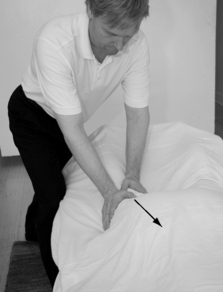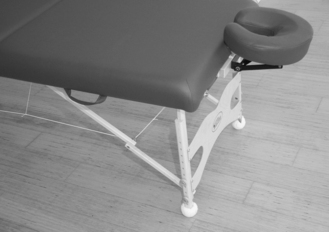3. Sports massage applications
Massage is considered to assist athletes to achieve enhanced performance levels and possibly reduce the risk of injury (Weerapong et al. 2005). Massage strokes generating mechanical pressure on muscles do either increase or decrease neural excitability through neurological mechanisms (Weerapong et al. 2005). This may allow the sports massage therapist to facilitate regulation of the muscle tone, either relaxing overly tensed muscles or stimulating relaxed muscles to enable faster muscle contractions. Other effects of massage include relaxation through increased parasympathetic activity and changes in cortisol levels (Weerapong et al. 2005). Psychological mechanisms like reduced anxiety and a better frame of mind also contribute to perceived relaxation (Hemmings, 2000 and Weerapong, 2005).
The manifestation of massage on athletes can often vary depending on country of origin, massage history, sporting habits, cultural values, etc. Sports massage used in Nordic countries like Sweden and Finland was initially not very different from a “regular” classic muscle massage. Some distinctions were, however, that a sports massage treatment could be more area specific for a particular sport, with additional focus on treatment depth and intensity. Since athletes commonly possess an elevated pain tolerance cultivated from endless hours of pushing their bodies through perceived performance limitations, Nordic sports massage was mostly implemented as a very strong and painful treatment as a result.
Sports massage continues steadily to evolve and is today divided into specific categories. Increased knowledge of sports physiology combined with empirical treatment experience has refined massage applications to be more specific in regard to the occasion and/or category of an event, environmental conditions, and sports-specific needs. These added requirements produced four basic differentiations (Benjamin and Lamp, 1996 and Archer, 2007):
Event-based sports massage:
• preevent massage
• interevent massage
• postevent massage.
Sports therapy massage:
• maintenance and remedial massage.
Preevent massage
Preevent massage is utilized prior to competition or training to support enhanced sport performance and to increase the “mechanical efficiency” (Meagher & Broughton 1990) of the athlete’s body. It is not intended to replace already existing warm-up routines since preevent massage has not demonstrated the capability to elevate the athlete’s blood circulation, core temperature, or ROM, or to prime the nervous system for upcoming sports-related movements, to the same extent as active warm-up routines produce (Archer 2007). Preevent sports massage does, however, serve as one important aspect of an athlete’s preparatory measures for upcoming sport activity. Research also suggests that massage can increase flexibility of muscles without a change in power, and may consequently serve as an alternative to static stretching during athletic warm-up (McKechnie et al. 2007). Other objectives of preevent sports massage are to increase blood circulation (Gillespie 2003) and local temperature in the treated tissues through mechanical and circulatory stimulation which may increase pliability of connective tissue in structures such as fascia, muscles, tendons, joint capsules, and ligaments (Archer 2007). This combined with therapeutic stretching techniques will also facilitate a desired ROM (Box 3.1).
Box 3.1
• Used to prepare athlete for event, support enhanced sport performance, and to increase the “mechanical efficiency” of the athlete’s body.
• Preevent massage is primarily conducted reasonably close to the actual event, normally 1h or less, and has a maximal duration of 10–20min.
• Preevent massage is performed rather superficially at a speed generally faster than the athlete’s resting heart rate, on performance-specific muscle groups.
• The preevent massage should start with the most active muscle groups, followed by the less active areas.
• Preevent massage does not contain structural integration or other deep tissue techniques.
• Preevent massage often contains gentle stretching of important muscle groups and fascial structures to facilitate the desired ROM.
Preevent massage is primarily conducted reasonably close to the actual event, normally 1h or less (Meagher and Broughton, 1990, Benjamin and Lamp, 1996 and Archer, 2007), but some therapists occasionally use it from several hours up to a couple of days before major sports activity (Ylinen and Cash, 1993 and Cash, 1996). Certain variations in preevent massage applications will depend on how close the treatment is administered prior to a competitive or training event. As a general rule, if the sports event starts within 1h, the massage is performed with increased speed and less depth on performance-specific muscle groups of the athlete’s body. This to ensure the desired effects occur where they are most relevant, and to keep the athlete stimulated to minimize the risk of reducing mental and physical “peak performance.” Although preevent sports massage is foremost intended as a more general preparatory measure for the athlete, the treatment focus is on muscles and fascial structures primarily stressed in each sport. The preevent massage should start on the most active muscle groups, followed by treatment of less active areas. If the massage has to end earlier than planned for some unforeseen reason, the most important muscle groups and fascial structures have thus already received treatment.
It is often common not to use any emollients such as oils, creams, gels, etc., during preevent massage, especially when treating endurance athletes or during elevated environmental temperatures. This is particularly valid for mineral-based products since they are believed not to be absorbed through the skin to the same degree as natural vegetable-based products. Some people are concerned that certain emollients may block the pores and thus reduce the athlete’s ability to expel heat during intense sports activity. Another more practical reason is that the athletes are commonly fully dressed to stay warm during the sport preparation, and it is easier and above all more time efficient, to perform the preevent massage over a sheet (Fig. 3.1) or, if circumstances permit, directly on the clothing.
In short-duration sport events requiring rapid reaction times and muscle contractions, the muscle tone needs to remain slightly elevated. Here, a fast-paced superficial preevent massage is desirable since a deeper and slower massage may cause unwanted levels of relaxation. A slow-paced more relaxing massage may, however, be in order in specific circumstances: if the athlete is too nervous and tense, a more soothing massage can lower the muscle tone to desired levels and facilitate recovery of the required mental focus. Asking athletes about their needs and habits prior to massage will clear up any possible confusion. Initiating unnecessary talk during the treatment is generally avoided during a preevent massage since it may disrupt the mental preparation routine athletes often have.
Event-based sports massage does generally not contain structural integration or other deep tissue techniques since the possible new movement patterns they produce can disrupt the neuromuscular conditioning the athlete has previously optimized. This can easily lead to reduced sports performance. This type of work is instead used during maintenance and remedial massage since it allows enough time for the athlete to recondition their nervous system to the new circumstances. As a general rule, sports massage is never static, but instead constantly adjusting to the athlete’s current needs and type of sport event they participate in.
See Box 3.2 for a list of suggested items to bring to event massage.
Box 3.2



 Get Clinical Tree app for offline access
Get Clinical Tree app for offline access

2. A fitted plastic sheet to protect the table surface.
3. Four cutout tennis balls for protection of wooden massage table legs (see Fig. 3.2).
4. Bolster or a bodyCushion system, and a pillow.
5. At least two thermal blankets: one placed on the massage table under a sheet, and the other to cover the athlete.
6. Enough sets of sheets for the treatments.
7. One warm blanket for the athlete.
8. Massage emollients for inter- or postevent massage.
9. Alcohol gel for hand sanitation between clients.
10. Rubbing alcohol for cleaning the table surface and headrest.
11. Paper towels.
12. Garbage bag.
13. Latex gloves as a protective barrier if blood or body fluids other than sweat are present.
14. Bleach solution (1 part bleach to 10 parts water). Used to clean hands and table if blood from the athlete is present.
15. Ice chest with small bags of crushed ice and/or cups of ice for possible hyperthermia treatment, pain relief, and as an additional part of cramp release treatment.
16. First aid kit.
17. Elastic ACE bandages.
18. Sunscreen/sunblock.
< div class='tao-gold-member'>
Only gold members can continue reading. Log In or Register to continue
Stay updated, free articles. Join our Telegram channel

Full access? Get Clinical Tree










